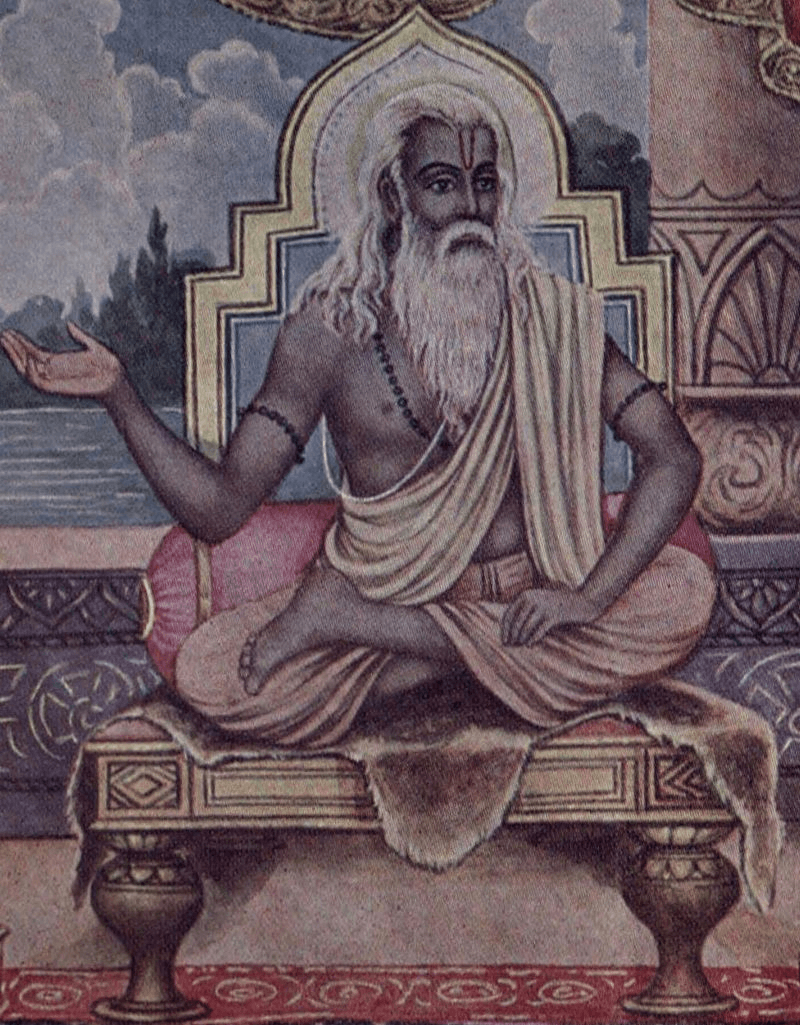Celebrations at Atal Akhada
MAHASHIVARATRI
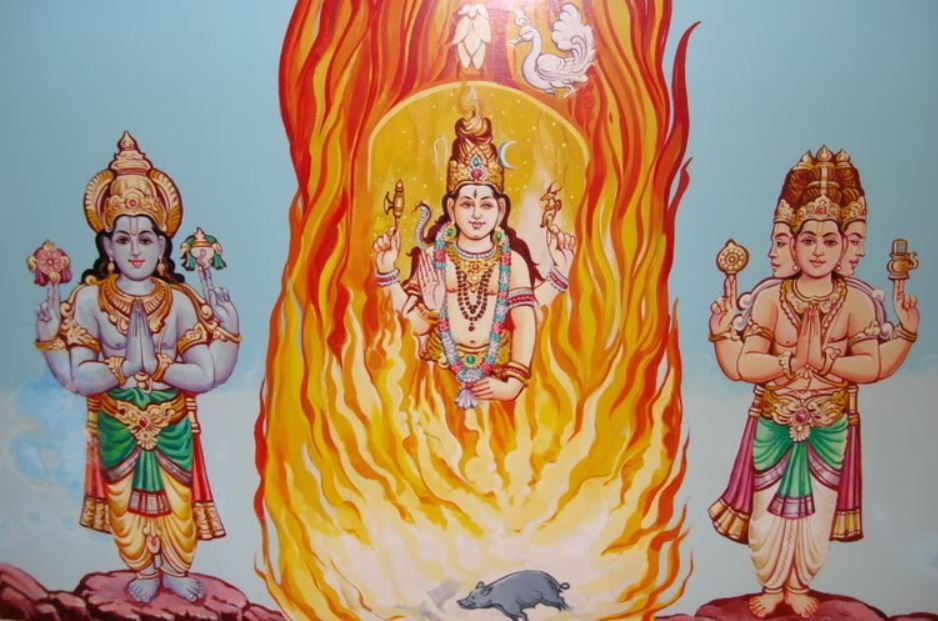
Picture: A painting depicting Lord Paramashiva manifesting as a fiery column of light, while Brahma takes the form of a Swan and flies upwards, while Vishnu takes the form of a boar and goes downwards, both in search of the beginning and end of Paramashiva.
Mahashivarathri is the day Lord Paramashiva assumed a form from his formless space. Paramashiva has existed eternally, with no beginning or end. He created Brahma and Vishnu, empowered Brahma to create and Vishnu to maintain the universe, and then he continued to remain in the formless space. However, when there was a conflict between the two, he appeared in the form of an infinite fiery column of light.
According to the Śiva Mahāpurāṇa, once Brahma (the god of creation) and Vishnu (the form of God during Preservation) had an argument over supremacy of creation. To settle the debate, Supreme God Shiva pierced the three worlds appearing as a huge Infinite Pillar of Light, the Jyotirlinga which later cooled into the Holy Mountain Annamalai (on which the Temple of Arunachaleshvara is located). Vishnu and Brahma split their ways to downwards and upwards respectively to find the end of the light in either direction. Brahma lied that he found out the end, while Vishnu conceded his defeat. Paramashiva, to cleanse Brahma of his Ego, cut off his fifth head, and cursed him that he would never be worshipped in any temple, while Vishnu would be worshipped forever.
This auspicious day is celebrated as Mahashivarathri each year, where devotees of Lord Paramashiva imbibe the very first teaching in Shaivism – “Shivoham” or “I am Shiva”. This day is celebrated by worshipping Paramashiva in the form of a Linga through rituals such as Rudrabhishekam (worship of the Shiva Linga through a ritual of pouring sacred items on it). Additionally, devotees fast on that day, and stay awake the entire night. Many visit the various Jyotirlingas of Paramashiva (shrines where He appeared in the form of a fiery column of light) across the country.

Mahashivaratri Celebrations by Mahants (Mahants belong to a particular administrative order) of Atal Peetha in Surat, Gujarat (West India)
Hanuman Jayanti

Lord Hanuman was born on the Anjaneri mountain. His mother Anjana was an apsara who was born on earth due to a curse. She was redeemed from this curse on giving birth to a son. The Valmiki Ramayana states that his father Kesari was the son of Brihaspati, he was the King of a place named Sumeru.Anjana performed intense prayers lasting 12 long years to Shiva to get a child. Pleased with their devotion, Shiva granted them the son they sought. He is known to be the incarnation of Paramashiva Himself.
Lord Hanuman is an ardent devotee of Lord Sri Rama and is widely known for his unflinching devotion to Sri Rama. Hanuman is the symbol of strength and energy. He is said to be able to assume any form at will, wield the gada (including many celestial weapons), move mountains, dart through the air, seize the clouds and equally rival Garuda (the vehicle-mount of Lord Vishnu in the form of an eagle) in swiftness of flight.
Lord Hanuman is worshipped as a deity with the ability to attain victory against evil and provide protection.
The devotees visit temples and apply tilaka of sindoor to their foreheads from Hanuman’s idol. As per legend, When Lord Hanuman found Sri Sita applying sindhūr to her forehead, He questioned her and she replied that doing so would ensure a long life for her husband, Lord Sri Rama. Lord Hanuman then proceeded to smear his entire body with sindhūr, thus ensuring Lord Sri Rama’s immortality.
(Ref: https://en.wikipedia.org/wiki/Hanuman_Jayanti)
It is also common practice to chant the Hanuman Chalisa (verses praising Lord Hanuman). On this day, large statues of Hanuman can be seen in procession on the streets across North India, particularly in Maharashtra. The deity of Hanuman is taken across the town with great celebration and pomp, where devotees sing and dance in His praise.


(left) the sacred deity of Lord Hanuman, a divine incarnation of Paramashiva; (right) Hanuman Jayanti (Birth anniversary of Lord Hanuman) Celebrations at Atal Peetha
Guru Purnima
A painting of a Guru blessing his student
This was the day when Krishna-Dwaipayana Vyasa – author of the Mahabharata – was born to sage Parashara and a fisherman’s daughter called Satyavati; thus this day is also celebrated as Vyasa Purnima. Veda Vyasa is also the compiler and organiser of the four Vedas (source text of Hinduism), by dividing them into four parts based on their use in the rites, characteristics and teaching them to his four chief disciples – Paila, Vaisampayana, Jaimini and Sumantu. It was this dividing and editing that earned him the honorific “Vyasa” (vyas = to edit, to divide). “He divided the Holy Veda into four, namely Rig, Yajur, Sama and Atharva. The histories and the Puranas are said to be the fifth Veda.”
Picture: (above) A painting of a Guru blessing his student.
(right) Veda Vyasa – the Compiler of the four Vedas.
(Ref: https://en.wikipedia.org/wiki/Guru_Purnima)
Guru Purnima is the traditional Hindu tradition of paying gratitude and reverence to one’s spiritual master, or Guru. This festival is traditionally observed by Hindus, Buddhists and Jains to revere their chosen spiritual teachers/leaders and express their gratitude. The festival is celebrated on the full moon day (Purnima) in the Hindu month of Ashadha (June–July) as it is known in the Hindu calendar.
The primary, fundamental, foundational first principle of Sanatana Hindu Dharma is Guru-Disciple relationship. On this day, devotees express their gratitude to their guru by making a traditional offering of coconut and rice to the Guru, called “Guru Mudi”. Coconut signifies ego, and rice signifies Karma, or a collection of unfulfilled experiences that stay in us and which constantly pull us to fulfill them. These are offered at the feet of the master, who takes away the ego and Karma of the disciple and gives him a new life.
Veda Vyasa – the Compiler of the four Vedas

Picture of a disciple washing the feet of his Guru on this auspicious occasion

Devotees gather to felicitate Their Guru and and receive blessings.
Krishna Janmashtami
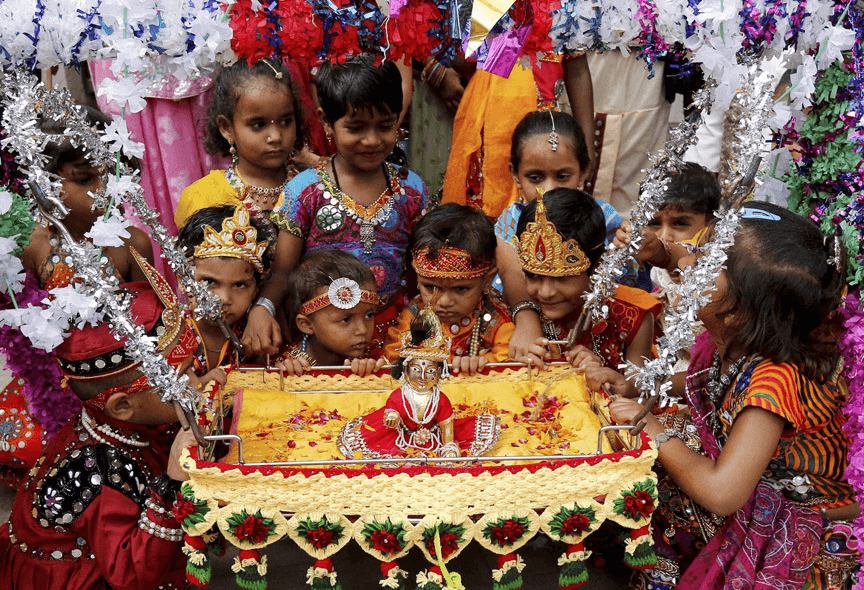
Krishna, the incarnation of Lord Vishnu, is the most bold and courageous lover. He is the embodiment of completion and love, simply in romance with the whole Cosmos. He is soaked in an eternal devotion. In fact, he was one of the Mahamandaleshwars of the Mahānirvaṇi Peetha, and refers to himself as the “Kapila” among the Siddhas meaning the perfect enlightened being.
Krishna shows the way to live life out of pure completion. He shows the way to radiate life with joy and bliss wherever you may be.
Janmashtami, the day of advent of Lord Krishna on the Planet is celebrated with great devotion and enthusiasm in India in the month of July or August. According to the Hindu calendar this religious festival is celebrated on the Ashtami of Krishna Paksh or the 8th day of the waning moon in the Vedic month of Bhadrapada.
Sri Krishna assumed the human body around 5,200 years ago in Mathura in Uttar Pradesh, North India. The sole objective of Sri Krishna’s birth was to free the Earth from the negative demons. He is the incarnation who steered the Mahabharata war and who delivered the Bhagavad Gita which taught bhakti (devotion) and good karma which are narrated so deeply in it.
Sri Krishna was born in a prison in the custody of the cruel King Kansa of Mathura. Vasudev, His father immediately thought of his friend Nand and decided to hand over his child to him to save Krishna from the clutch of Kansa. Krishna grew up in Gokul in Uttar Pradesh, North India and finally destroyed his evil uncle, King Kansa.
The actual celebration of Janmashtami takes place during the midnight as Sri Krishna is believed to be borned on a dark, stormy and windy night to end the rule and violence of his uncle, Kansa. All over India this day is celebrated with devotional songs and dances, pujas (ritualistic worship), arati (offering of the sacred flame to Sri Krishna), blowing of the Conch and rocking the cradle of baby Sri Krishna.
(Ref: https://www.calendarlabs.com/holidays/india/janmashtami.php)
Rama Navami

A group of devotees enact the scenes of Ramayana, the glorious life story of Lord Rama when He incarnated as the seventh incarnation of Lord Vishnu.
Rama Navami is the day when Lord Rama, the seventh incarnation of Lord Vishnu, incarnated in human form in the land of Ayodhya, North India. The word “Rama” literally means one who is divinely blissful and who gives joy to others, and one in whom the wise Sages rejoice.
Ram Navami falls on the ninth day of the waxing moon in the Vedic month of Chaitra (April/May). This day is also observed as the divine marriage ceremony day of Rama and His Consort Sita and thus also referred to as Kalyanotsavam.
The story of the Ramayana is a classic, eternal, universal message of Dharma versus adharma, of deva versus demon, of good versus evil, as represented in the battle between Rama and the demon King Ravana.
Lord Rama is an Avatar of Lord Vishnu who came down to earth to battle the invincible Ravana in human form. Lord Brahma had been receiving complaints from all the gods about the havoc that Ravana was wreaking on earth, but because Lord Brahma had granted Ravana so many boons, he could not be killed by a God. But Ravana had become so overconfident that he would never expect an attack from a human being. So Lord Vishnu agreed to go down to Planet earth in the form of Prince Rama, the son of King Dasharatha and Queen Kaushalya and destroy Ravana. The killing of Ravana is symbolically the killing of the deep ignorance and negativity inside every unenlightened human, so he may attain enlightenment or superconsciousness.
Diwali
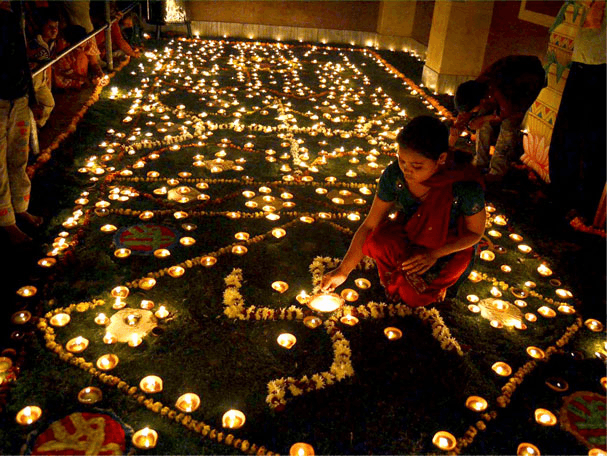
Diwali, also known as Deepavali or Deepawali is one of the most important, hugely waited and immensely cherished festival celebrated across India and in parts of Nepal. Originally, the name was Deepawali, which has its origin from Sanskrit, meaning “Rows of Deep” (deep meaning Light).
According to the Hindu calendar, the festival of Diwali is celebrated on the new moon day that marks the end of the Vedic month of Ashwini and beginning of the month of Kartika (November -December.
Significance:
The festival of Diwali is not only significant to Hindus, but has importance in Jainism, Buddhism, and Sikhism. For Hindus, it is associated with the return of Lord Rama to Ayodhya, after his 14 years of exile and victory over the demon Ravana.
On the day of his return, King Rama was welcomed to the kingdom of Ayodhya with rows of Deep (lamps), lit throughout the kingdom.
Thus, there is a tradition of lighting oil lamps that symbolize the victory of good over evil and freedom from spiritual darkness.
Hindus, also make preparations to welcome goddess Lakshmi by drawing Rangoli, and Paduka (footsteps) at the entrance that would allure Goddess Lakshmi to visit one’s home and bring prosperity along with her.
Customs
There are numerous customs and traditions associated with Diwali, such as bursting of firecrackers, lighting of lamps, wearing new clothes, distribution of sweets, exchange of gifts etc. The crackers symbolise illumination in one’s life after dispelling of the darkness.
A Five Day Festival
Diwali celebrations spread across five days in North India, with each day having its own significance and set of rituals.
The first day is called “Dhanteras”, on which new utensils and silverware is brought to the house. The second day is called “Chhoti Diwali”, which normally involves preparation for the next day. The third day is the “Badi Diwali”, which involves the worship of Goddess Lakshmi, the Goddess of wealth and prosperity. The fourth day is the Govardhan Puja and finally the five days end with Bhai Dooj.
The festival of Diwali is truly a “Festival of Lights”, as it not only involves lighting of Lamps but, it brings the light of happiness, togetherness, spiritual enlightenment and prosperity for everyone.
Reference – https://www.speakingtree.in/blog/importance-of-diwali
Krishna shows the way to live life out of pure completion. He shows the way to radiate life with joy and bliss wherever you may be.
Janmashtami, the day of advent of Lord Krishna on the Planet is celebrated with great devotion and enthusiasm in India in the month of July or August. According to the Hindu calendar this religious festival is celebrated on the Ashtami of Krishna Paksh or the 8th day of the waning moon in the Vedic month of Bhadrapada.
Sri Krishna assumed the human body around 5,200 years ago in Mathura in Uttar Pradesh, North India. The sole objective of Sri Krishna’s birth was to free the Earth from the negative demons. He is the incarnation who steered the Mahabharata war and who delivered the Bhagavad Gita which taught bhakti (devotion) and good karma which are narrated so deeply in it.
Sri Krishna was born in a prison in the custody of the cruel King Kansa of Mathura. Vasudev, His father immediately thought of his friend Nand and decided to hand over his child to him to save Krishna from the clutch of Kansa. Krishna grew up in Gokul in Uttar Pradesh, North India and finally destroyed his evil uncle, King Kansa.
The actual celebration of Janmashtami takes place during the midnight as Sri Krishna is believed to be borned on a dark, stormy and windy night to end the rule and violence of his uncle, Kansa. All over India this day is celebrated with devotional songs and dances, pujas (ritualistic worship), arati (offering of the sacred flame to Sri Krishna), blowing of the Conch and rocking the cradle of baby Sri Krishna.
(Ref: https://www.calendarlabs.com/holidays/india/janmashtami.php)
Ganesh Chaturthi
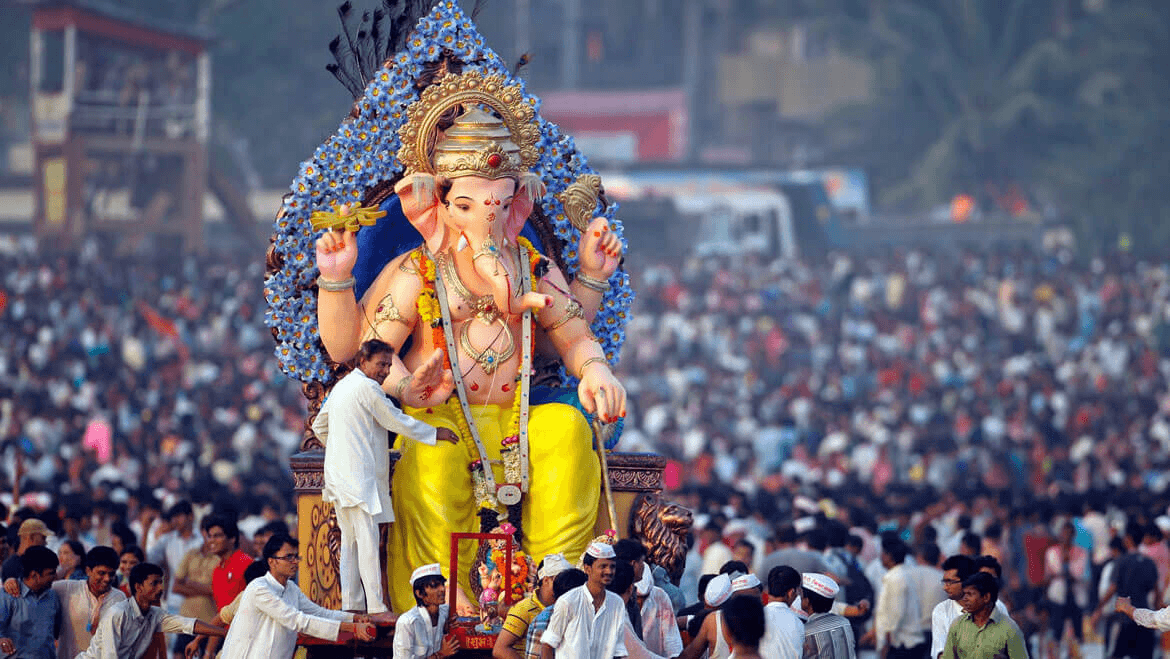
Ganesh Chaturthi also known as Vinayaka Chaturthi is one of the important Hindu festivals celebrated throughout India with great devotion and also by the Mahanirvani Peetha. Ganesha is Paramasiva’s own son This day is celebrated as the date of his advent. Lord Ganesh is the symbol of completion, wisdom, prosperity and good fortune.
Completion means being free from all inadequate painful cognitions about past happenings and people and being an embodiment of pure joy and bliss. He is the only deity who does not demand any rules or Agamic procedures (Agamic meaning from the revealed scriptures of Paramasiva) to be followed in His worship – simply remember Him and He appears!
Ganesh Chaturthi is celebrated on Shukla Chaturthi (meaning the waxing phase of the moon, when the moon is 48 longitudinal degrees from the Sun) of the Hindu month of Bhadra (generally falls between August and September). People bring deities of Lord Ganesha to their homes and offer worship. The duration of this festival varies from 1 day to 11 days, depending on the place and tradition. On the last day of the festival all the Ganeshas from all private and public places are taken out in a colorful and musical procession and immersed traditionally in a water body.
As per Hindu History, Lord Ganesh is considered as “Vigna Harta” (one who removes obstacles) and “Buddhi Pradaayaka” (one who bestows intelligence). This festival is very important for students, as they enter into Oneness with Lord Ganesh to illumine their minds.
Dussehra or Navaratri


Dussehra or Navaratri is an important festival which is celebrated at the end of Navratri every year. It is a celebration of the victory of good over evil. Every year as per Hindu calendar, this important festival is celebrated on the tenth day of the Vedic month of Ashvini (Sep – Oct).
The day marks the victory of the seventh incarnation of Vishnu – Lord Rama when he killed the ten-headed demon Ravana and thereafter handed over the throne of kingdom Sri Lanka to Ravana’s brother Vibhishana. The word ‘Dussehra’ is derived from two Sanskrit words – ‘dasha’ and ‘hara’ – that mean defeating the ten (referring to the ten heads of the evil force of Ravana). The day also marks the end of Durga Puja, where people remember goddess Durga’s victory over the buffalo demon Mahishasur and a host of demons as narrated in the chant “Chandi”, to help restore Dharma.
Durga led a battle against Mahishasur and it lasted for nine days and nine nights killing several demons in the event. Durga killed Mahishasur on the tenth day. Therefore, different manifestations of goddess Durga are worshipped during the nine-day long Navratri festival each year. The tenth day is dedicated to Durga and is called Vijayadashmi. The feminine power is worshipped and celebrated during the festival of Navratri. Navratri celebration culminates with Dussehra on the tenth day, when the deity of goddess Durga is immersed in a river or a lake sending her away ceremoniously into the divine space where she came from for the ten days of worship..
People celebrate the festival in different ways across the country. In North India, various colorful fairs are organised. Plays based on the story of Ramayan, which is known as Ramleela are performed. On the day of Vijayadashami, huge effigies of Ravan, Meghnad (Ravana’s son) and Kumbhakarn (Ravana’s brother) are also set on fire.
Reference – https://www.financialexpress.com/india-news/dussehra-2017-history-importance-significance-of-this-festival/875622/


